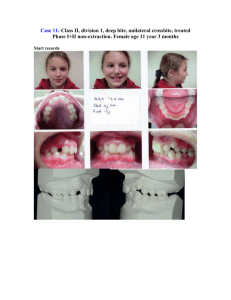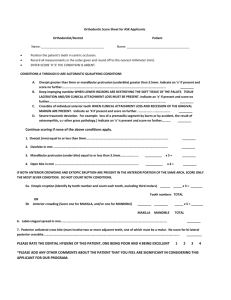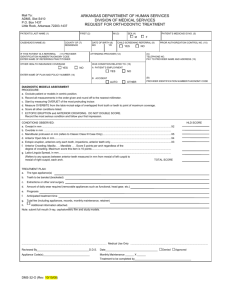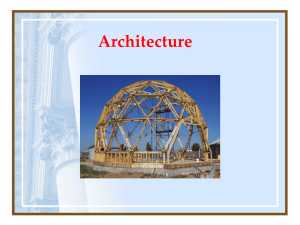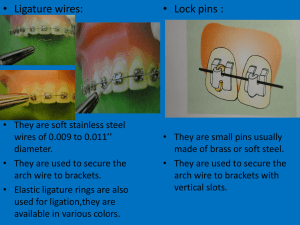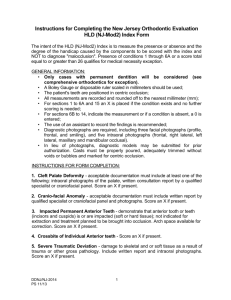treatment options for management of mandibular anterior crowding
advertisement
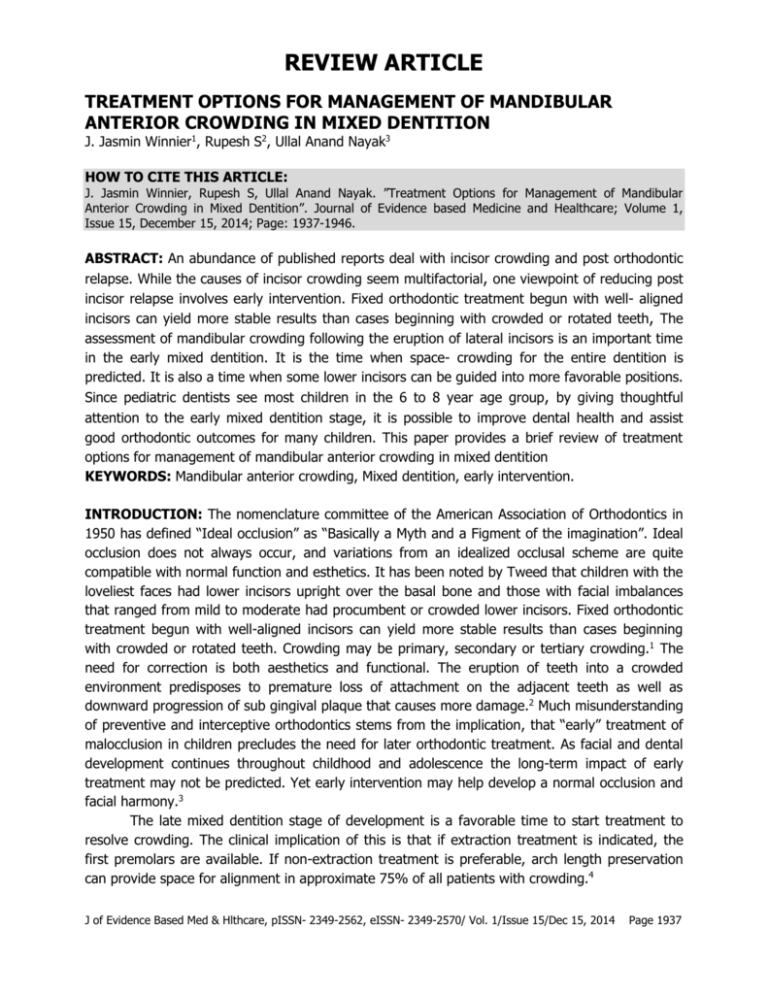
REVIEW ARTICLE TREATMENT OPTIONS FOR MANAGEMENT OF MANDIBULAR ANTERIOR CROWDING IN MIXED DENTITION J. Jasmin Winnier1, Rupesh S2, Ullal Anand Nayak3 HOW TO CITE THIS ARTICLE: J. Jasmin Winnier, Rupesh S, Ullal Anand Nayak. ”Treatment Options for Management of Mandibular Anterior Crowding in Mixed Dentition”. Journal of Evidence based Medicine and Healthcare; Volume 1, Issue 15, December 15, 2014; Page: 1937-1946. ABSTRACT: An abundance of published reports deal with incisor crowding and post orthodontic relapse. While the causes of incisor crowding seem multifactorial, one viewpoint of reducing post incisor relapse involves early intervention. Fixed orthodontic treatment begun with well- aligned incisors can yield more stable results than cases beginning with crowded or rotated teeth, The assessment of mandibular crowding following the eruption of lateral incisors is an important time in the early mixed dentition. It is the time when space- crowding for the entire dentition is predicted. It is also a time when some lower incisors can be guided into more favorable positions. Since pediatric dentists see most children in the 6 to 8 year age group, by giving thoughtful attention to the early mixed dentition stage, it is possible to improve dental health and assist good orthodontic outcomes for many children. This paper provides a brief review of treatment options for management of mandibular anterior crowding in mixed dentition KEYWORDS: Mandibular anterior crowding, Mixed dentition, early intervention. INTRODUCTION: The nomenclature committee of the American Association of Orthodontics in 1950 has defined “Ideal occlusion” as “Basically a Myth and a Figment of the imagination”. Ideal occlusion does not always occur, and variations from an idealized occlusal scheme are quite compatible with normal function and esthetics. It has been noted by Tweed that children with the loveliest faces had lower incisors upright over the basal bone and those with facial imbalances that ranged from mild to moderate had procumbent or crowded lower incisors. Fixed orthodontic treatment begun with well-aligned incisors can yield more stable results than cases beginning with crowded or rotated teeth. Crowding may be primary, secondary or tertiary crowding.1 The need for correction is both aesthetics and functional. The eruption of teeth into a crowded environment predisposes to premature loss of attachment on the adjacent teeth as well as downward progression of sub gingival plaque that causes more damage.2 Much misunderstanding of preventive and interceptive orthodontics stems from the implication, that “early” treatment of malocclusion in children precludes the need for later orthodontic treatment. As facial and dental development continues throughout childhood and adolescence the long-term impact of early treatment may not be predicted. Yet early intervention may help develop a normal occlusion and facial harmony.3 The late mixed dentition stage of development is a favorable time to start treatment to resolve crowding. The clinical implication of this is that if extraction treatment is indicated, the first premolars are available. If non-extraction treatment is preferable, arch length preservation can provide space for alignment in approximate 75% of all patients with crowding.4 J of Evidence Based Med & Hlthcare, pISSN- 2349-2562, eISSN- 2349-2570/ Vol. 1/Issue 15/Dec 15, 2014 Page 1937 REVIEW ARTICLE The limitations of early treatment are that it has sometimes been equated with a naïve attempt to prevent or intercept all malocclusions. Improper early treatment can be harmful. Early diagnosis and treatment planning are more tentative and periodic assessment is a necessity.5 Early intervention demands brainpower, evaluation, individual reflection, planning and a decision based on the information available. The following review suggests methods of dealing with mandibular anterior crowding, following eruption of mandibular lateral incisors. STRIPPING OF TEETH TO RESOLVE CROWDING: A diamond disc can be used for stripping of teeth to resolve minor discrepancies of about 2-4 mm, but Air Rotor Stripping (ARS) is needed for greater enamel reduction.6 Treatment planning for this type of proximal reduction includes-complete set of radiographs and models. From the radiographs, the clinician can determine the convexity of each proximal surface, thickness of enamel on each tooth, size of restorations if any and the disposition of roots. The stripping technique involves three steps: Reduction, Re contouring and Protection.7 With a micro-motor and a high-speed hand piece, these three steps can be performed for one arch in one appointment. If the total amount of possible reduction in each quadrant is less than the amount of space needed, then another treatment must be chosen. The distal surface of first molars and the second and third molar should not be stripped, if possible, to preserve anchorage. If crowding is moderate (2-6mm) sequential slicing of posterior deciduous teeth can allow the spontaneous alignment of incisors, distal eruption of canines and premolars.8 Stripping of proximal surface of deciduous teeth is based on the assumption that it is possible to predict at a very early age that the alveolar ridge will not develop sufficiently to accommodate all the permanent teeth. This assumption is very precarious since there does not exist any growth prediction system that can be considered accurate in regard to the amount of growth that would take place.9 Sequential slicing of deciduous teeth is only mildly invasive, needs no patient cooperation, no long-term appliance supervision, When at least half the primary tooth root is resorbed; there is virtually no dental sensitivity. Mild gingival inflammation is common.10 The Air Rotor Stripping (ARS) technique that was proposed by Sheridan J.J (1985) has undergone several modifications. “This technique removes the interdental enamel primarily, but not exclusively in the buccal segments” ARS consistently resolves moderate crowding of 4-8mm and is a valuable treatment option in borderline extraction cases. If 6mm crowding is present 6mm enamel is removed. The proximal thickness of enamel is constant throughout one’s lifetime, so there is no reason to limit the treatment to adults. Enamel is often considerably reduced in lower arch without compensatory reduction in upper arch, yet intercuspation of all cases was found to be good or excellent. Thus, acceptable intercuspation is possible over a range of tooth size dimensions, rather than with a specific ratio.11 The guidelines for ARS are as follows: Measure and chart the accruing space, Limit interdental reduction to 1mm per contact, Ensure that the enamel walls are parallel, Finish the proximal walls as smoothly as possible, Contour the teeth to resemble original morphology.12 For severe crowding, however extractions are necessary. J of Evidence Based Med & Hlthcare, pISSN- 2349-2562, eISSN- 2349-2570/ Vol. 1/Issue 15/Dec 15, 2014 Page 1938 REVIEW ARTICLE Periodontal complication may occur following air rotor stripping which are primarily related to the presence of plaque and not the effect of decreased interproximal tissue or altered morphology of contact points.11 Earlier reports had indicated that alveolar bone will be compressed as the interradicular spaces are closed following reduction of enamel. However, there is no evidence linking this process with the disease. It has been reported that the furrows appear in the posterior interdental enamel after ARS. Even under in vitro conditions with the finest finishing strips, it was not possible to produce an enamel surface free of furrows that result from the initial abrasion caused by coarse strip. The use of dental floss did not result in prevention of plaque accumulation along the bottom of the furrows.13 The newly developed Safe Tipped ARS burs (STARS) exclude inadvertent scarring of enamel and ultrafine finishing burs can reduce the interproximal ridges and grooves induced by ARS to 15 microns and normal function would reduce these ridges even further. Thus, stripped interproximal enamel texture eventually approaches that of unaltered surfaces.14 Evaluation of the long term stability of stripped mandibular incisors showed that the stripped group had 25% less crowding that the non-stripped group. Thus it is a useful clinical method in reducing the amount of relapse after treatment.15 Taking all above factors into consideration, it has been validated in the clinic and examined in the literature that by all accounts ARS appears to be a sensible treatment option.12 MANDIBULAR EXPANSION: It is well known that expansion of dental arches can be produced by a variety of orthodontic treatments. The type of expansion produced can be arbitrarily divided into orthodontic expansion, passive expansion or orthopedic expansion. It has been claimed that expansion of lower arch will cause breakdown of labial gingival attachment.16 Schwarz appliance is considered synonymous with any removable expansion appliance that incorporates one or more expansion screws.17 It is particularly effective in the 6 to 9 year old age group.18 In a case with mandibular incisor crowding of 3 to 4 mm an Schwarz appliance is indicated and the patient is instructed to activate the appliance once per week. About 1mm of expansion was produced with every 5 turns, and less than 1mm of expansion occurs during each month of wear. The appliance is worn as an active appliance for 5 to 6 months, on a full time basis including during meals appliance is to be removed only during brushing. At the end of this time a tendency toward a lingual cross bite is observed. If the crowding is severe, no attempt needs to be made to resolve all arch length discrepancy by lower arch expansion, and some minor residual crowding remained when the active turning of the appliance is terminated. Later a lingual holding arch maintains the leeway space that was gained in the transition of the mandibular second deciduous molars to premolars (approximately 2.5mm per side). At the end of the interim period invariably sufficient space is available to allow for the alignment of mandibular dentition without extraction or interproximal reduction. Thus, this appliance produces orthodontic (not orthopedic) movement of the mandibular incisors. For gross tooth size/arch length discrepancy problem, serial extraction procedure is indicated.19 By traditional orthodontic education, one of the cardinal rules of orthodontics is that expansion of the distance between mandibular canines is relatively unstable. Study on transverse J of Evidence Based Med & Hlthcare, pISSN- 2349-2562, eISSN- 2349-2570/ Vol. 1/Issue 15/Dec 15, 2014 Page 1939 REVIEW ARTICLE expansion of the mandibular arch and has concluded that transverse expansion was more stable in the posterior region of mandibular dental arch than anterior region and mandibular inter canine width increase could be maintained only by fixed retention.20 In general the lip bumper shields the soft tissue from the dentition allowing for spontaneous arch expansion. However, many clinicians tend to favor the use of Schwarz appliance over lip bumper in most instances because of predictability of treatment outcome and the ease of clinical management. Only in patients with very constricted (tense) soft tissue is the lip bumper the appliance of choice.19,21 The Schwarz appliance is activated on a once per week basis; thus, the amount and rate of expansion is under the control of the orthodontist. In contrast, the rate of treatment response with the lip bumper varies widely among patients.19 THE EXTRACTION TREATMENT: Orthodontic extractions are indicated if arch length discrepancy is 10mm or more. Borderline cases have the discrepancy of 5 to 9mm, while nonextraction cases fall in less than 4 mm discrepancy category.22 Extractions may be balancing extractions or compensating extractions. The first recorded study on facial growth was that of John Hunter (1771). From many observations it has been concluded that - No new bone of consequence in the anterior position of the mandible is laid down by apposition after the age of six or later and internal expansion by interstitial growth in this region is impossible. Arch length mesial to first permanent molars tend to decrease rather than to increase on the interchange of teeth between the mixed to permanent dentition. So, when the normal development has failed to take place, the alternatives should be considered.23 SERIAL EXTRACTION: In the year 1743, French man Robert Bunon in his “Essay on diseases of teeth” first described the principle of early treatment associated with extraction of primary teeth followed by the removal of permanent teeth. Kjellgren (1929) introduced the term serial extraction.24 Hotz RP (1970) stated that serial extraction is an incorrect, misleading recipe and it tends to oversimplify. It implies a cookbook method of treatment. Guidance of eruption may mean extraction or only proximal stripping of deciduous teeth, or using functional forces with simple appliances or through a combination of various means, which are referred to as minor orthodontic measures.25 Ackerman and Profitt (1980) have stated that serial extraction is “strong in theory but weak in practice”.26 Generally serial extraction in the maxilla Spontaneous space closure and axial inclinations are usually favorable in the upper arch. But because of a more favorable size ratio between deciduous and permanent teeth extraction of premolars can often be avoided and incisor extraction may be indicated.25 The ideal sequence of serial extraction is more often the rule in maxillary arch than in the mandibular arch.23 Dale JG (2002)27 has stated that if the total discrepancy is 8 mm or more, then remove all four deciduous canines first primary molars and first premolars at the same time. If the discrepancy is 5 mm the second premolars may be extracted, the earlier the better. He has also stated that for a mixed dentition case a treatment time of 5 months is typical to achieve facial balance. J of Evidence Based Med & Hlthcare, pISSN- 2349-2562, eISSN- 2349-2570/ Vol. 1/Issue 15/Dec 15, 2014 Page 1940 REVIEW ARTICLE Lower incisor extraction Treatment: Incisor extraction to solve crowding problems is not a new idea. Jackson (1904) had illustrated a case where two incisors had been extracted. Salzmann (1963) reviewing Edward. H. Angles philosophy of extraction in orthodontics noted that Angle regarded the extraction of an incisor, when the tooth was sound to be inexcusable. Angle had also warned that extracting one incisor, would lead to disharmony of occlusal plane and abnormal incisor overbite.28 Gellin ME (1989)29 has stated that since the mandibular permanent incisors erupt lingually to the corresponding permanent tooth, its self-correction usually occurs by 8 years of age. If correction does not occur by this age it is considered as over retained and extraction is indicated. The patient should fit in the following criteria for success of single lower incisor extraction treatment - A Class I molar relationship, indicating that final buccal interdigitation will be acceptable. Moderately crowded lower incisors with minimal to moderate over bite and over jet, which can be solved by single lower incisor extraction. Minimal growth potential, since in growing patient non-extraction therapy should be considered before contemplating incisor extraction. Missing laterals or peg laterals which can resolve inevitable tooth size discrepancy out any stripping or recontouring.30 lower anterior region is not suitable for stripping due to shape and small size of lower incisors.31 SECOND MOLAR EXTRACTIONS IN THE LOWER ARCH: Dr. H.E. Wilson might be called as the father of second molar extraction concepts. He observed that the posterior teeth could be distalized to relieve crowded anteriors while at the same time allowing the face and jaws to continue to be developed downward and forward, the natural way, protecting the TMJ in that process.32 Second molar extractions provides about 10 to 12 mm of space and when this space is not used by rearrangement of anterior teeth and bicuspids it is used up when the third molars erupt and move forward to close contact with the first molar.33 The benefits of lower second molar extraction remain a controversial issue in orthodontics in contrast to the well-recognized upper second molar extractions for retraction of upper anteriors. The reason for this is twofold. The less predictable eruption pattern of the lower third molar compared with that of the corresponding upper tooth and the uncertainty as to the amount of space that may become available in the lower arch. Thus, the lower third molar is less likely to erupt into as good an occlusion as the second molar it replaces. Impaction against the first molar is a rare but awkward clinical complication, requiring additional orthodontic treatment to upright the third molar in the late teenage years.34 The possible Disadvantages may be that too much tooth substance removed in class I malocclusions with mild crowding, with the extraction site far from the area of concern in moderate to severe anterior crowding and possible impactions of third molars.35 Second molar extractions could be done between ages of 10 or 11 years in lower arch and even up to 20 years for upper arch.36 Second molar extractions provide no significant space in the anterior part of the arch but extraction at 14 to 16 years may minimize deterioration in lower incisor alignment.35 An average decrease in crowding of 0.35 to 0.8 mm over 5 years was noted. Cases correctly treated with second molar extractions are found to show overwhelmingly consistent stability but the other factor to be considered is that individual treated with second molar extractions are also usually J of Evidence Based Med & Hlthcare, pISSN- 2349-2562, eISSN- 2349-2570/ Vol. 1/Issue 15/Dec 15, 2014 Page 1941 REVIEW ARTICLE recipients of functional appliance treatment during some phase of treatment plan.36 Evidence suggest that, need for relief of molar premolar crowding is a indication for second molar extraction. Third molar development is “predictably unpredictable” and may need further treatment to orthodontically upright them.37 In summary the role of second molar extractions without appliance therapy in alleviating existing mandibular anterior crowding has not been documented. However, the extraction of second molars to prevent further imbrication of mandibular anterior teeth adds a new variable to the maturational process. Therefore the effect of these interceptive extractions on late anterior crowding needs to be evaluated carefully.35 LOWER FIRST MOLAR EXTRACTIONS: The extraction of a first molar is not commonly done in orthodontic therapy since it does not provide adequate space to resolve the incisor crowding, it results in deepening of the bite and second premolar may tip into the extraction space. Also mastication may be affected. It may be considered in Grossly decayed molar or a heavily filled tooth. Open bite cases may benefit from such extractions since there is a tendency for the bite to deepen after extraction of first molar. Wilkinson advocated the extraction of all first permanent molars between the ages of 8 and half to 9 and half years. The basis for such extractions is the fact that the first permanent molars are highly susceptible to caries and the impaction of third molars can be avoided. Due to a number of drawbacks such extractions are not followed.38 THE MANDIBULAR LIP BUMPER: The lip bumper can be used to gain an incredible amount of space in the lower arch, while maintaining a good control of the molars and incisors.39 It is an alternative for extraction therapy in mild to moderately crowded arches.40 It can gain and maintain arch length, width and perimeter.41 For obtaining optimal adaptation of the appliance, the Transverse position the wire must be 2 mm away from the lower canines and 3 to 4 mm from the premolars or generally be 2.5 mm away from the facial surface of teeth.41 In the anterior region, depending on the overbite, the bumper can be positioned at the Incisal edge, middle third or the gingival level. The appliance should be worn 24 hours a day and should be removed only for meals and hygiene. If the lip bumper is well fitted, a red line can be seen on the inside of the cheek and lower lip where the wire runs. If the bumper is too distant from the teeth, ulcers may appear. At each appointment the bumper is checked to see that it is still passive on the molars and that it maintains the desired distance from the teeth.39 The individual differences among observers may be due to differences in the clinical manipulation of the appliance. The potential sources of discrepancy include: Inciso gingival position of lip bumper, Height of labial shield, Presence of buccal shield, Duration of Lip bumper wear.42 95% of patients treated only with lip Bumper for 2-10 months showed forward migration of mandibular incisors & distal movement of first molars.43 When the second molars are used as abutments for lip bumper 4mm increase in width of first molar area has been reported. Apparently, it is possible to get 4.5-mm expansion in the premolar region within 2 years by adding a buccal acrylic shield to the appliance.40 The forces on the mandibular molars are J of Evidence Based Med & Hlthcare, pISSN- 2349-2562, eISSN- 2349-2570/ Vol. 1/Issue 15/Dec 15, 2014 Page 1942 REVIEW ARTICLE different with different types of lip bumper (wire and acrylic shield). Acrylic lip bumper produced higher forces than wire lip bumper, and forces were higher if the lip bumper was 4mm anterior when compared to 2mm away from mandibular incisors. Also, the positioning of lip bumper at the height of gingival margin produced higher forces than at middle of clinical crown.44 Vestibular shield allows the dental arch to expand and also encourages adaptation of lips and cheeks so that the pressure that they exert on teeth is less than it would have been if the teeth had been moved labially with routine orthodontic treatment. Theoretically, this decrease in pressure should lead to increased treatment stability. 41 Active proclination of the incisors resulted in increased resting pressure on the incisors from the lip, passive proclination with lip bumper did not result in such pressure. Further studies are needed to find out how much of incisor proclination can be tolerated before increase in pressure occurs.34 It has been reported that 50% of total expansion occurs in the first 100 days of treatment and 90% of total expansion is achieved within the first 300 days and the subsequent expansion is minimal. Thus it is not needed to have the appliance in place for longer than 300 days.45 THE LINGUAL ARCH: A large percentage of cases referred to orthodontic treatment are in mixed dentition, and the orthodontist usually suggests postponement of comprehensive treatment until the patient reaches the late mixed dentition.46 However during the transition from mixed to permanent dentition if the arch length is maintained with the use of passive lingual arch, it helps to liberate the leeway space for incisor alignment and provides adequate space to resolve incisor crowding in many instances.47 The stability of the lingual arch is improved by including an open loop in the bicuspid area for adjustability. Using anchorage sites at the gingival level of the premolars and buttressing the arch against the cingulum area of the canines also helps to improve stability.48 When properly constructed and used, the lingual arch may cause some minor inconveniences such as tenderness of teeth for 2 or 3 days after activation. The lingual arch may be designed for rigidity when stability is needed, or can be made flexible for tooth movement.46 It has been noted that sufficient space to resolve crowding was available after lingual arch therapy in 70% of patients. Lingual arch also helps to reduce arch perimeter loss, but at the expense of slight mandibular incisor proclination. It is important to limit any arch length increase to less than 1mm per side. Largest post retention irregularity index (6.06mm) occurred in patients whose arch lengths were increased more than 1mm in the mixed dentition.32 The basic principles to be followed to prevent relapse may be summarized as follows: The patient’s pre-treatment lower arch form and Original inter-canine width should be maintained during orthodontic treatment as much as possible; Advancing the lower incisors is unstable and should be considered as seriously compromising lower anterior post treatment stability. Fiberotomy is an effective means of reducing rotational relapse. Lower incisor reproximation shows long-term improvement in post treatment stability.11 CONCLUSION: Esthetics are judgments usually established on cultural basis, and consequently esthetically desirable facial features show immense variations. Whatever the malocclusion, it is nearly always stable after growth has been completed. If an orthodontic problem is corrected in J of Evidence Based Med & Hlthcare, pISSN- 2349-2562, eISSN- 2349-2570/ Vol. 1/Issue 15/Dec 15, 2014 Page 1943 REVIEW ARTICLE adult life, which can be more difficult, because so much of treatment depends on growth, a surprising amount of change is also stable. The etiologic factors in other words are no longer present when growth is completed. In children, though appliance therapy tends to be simpler than in adults, the treatment planning and monitoring are more complex. Whenever treatment is done in children the totality of all the changes should be taken into account because malocclusion, after all is a developmental problem. Pediatric dentists see most children in the age group of 6 to 8 years and they are challenged with the responsibility of early diagnosis and treatment of functional disturbances and arch length discrepancies. The sequence and timing of therapy necessary to achieve a satisfactory result rely on the understanding of the process of growth and development. Clearly spelled out objectives of treatment should facilitate the monitoring of treatment progress in the proper direction. BIBLIOGRAPHY: 1. Tsai H.H: Dental crowding in primary dentition and its relationship to arch and crown dimensions; ASDC. J. Dent Child; 2003: 164-169. 2. Ruf S, Hansen K, Pancherz H: Does Orthodontic proclination of lower incisors in children and adolescents cause gingival recession?; Am. J. Orthod Dentofac. Orthop; July 1998; 114 (1): 100-106. 3. Arvystas MG: The Rationale for Early Orthodontic treatment; Am. J. Orthod. Dentofac. Orthop; Jan 1998; 113 (1): 15-18. 4. Gianelly AA: Crowding: Timing of treatment; Angle. Orthod; 1994 (6): 415-418. 5. Moyers RE: Handbook of Orthodontics; 4th Edition; Yearbook Medical Publishers, Inc. 6. Owen A.H: Single lower incisor Extractions; J. Clin. Orthod; Mar 1993; 27 (3): 153-160. 7. Philippe J: Method of Enamel reduction for correction of Adult Arch-Length discrepancy; J. Clin Orthod; Aug1991: 484-489. 8. Rosa M, Cozzani M, Cozzani G: Sequential slicing of lower deciduous teeth to resolve incisor crowding; J Clin. Orthod; Oct 1994; 28 (10): 596-599. 9. Lee. PK: Behaviour of erupting crowded lower incisors; J. Clin. Orthod; Jan 1980: 24-33. 10. Rosa M, Cozzani M, Cozzani G: Sequential slicing of lower deciduous teeth to resolve incisor crowding; J Clin. Orthod; Oct 1994; 28 (10): 596-599. 11. Sheridan JJ: Air-Rotor Stripping Update; J. Clin. Orthod; Nov 1987:781-788. 12. Sheridan JJ: The Physiologic Rationale for Air Rotor Stripping; J. Clin. Orthod; Sep 1997: 609-612. 13. Radlanski RJ, Jager A, Schwestka R, Bertzbach F: Plaque accumulations caused by interdental stripping; Am. J. Orthod. Dentofac. Orthop; Nov 1988, 94 (5): 416-420. 14. Sheridan JJ, Hastings J: Stripping and lower incisor Extraction treatment; J. Clin. Orthod; Jan1992: 95-98. 15. Sparks AL: Interproximal enamel reduction and its effect on the long-term stability of mandibular incisor position; Am. J. Orthod. Dentofac. Orthop; 120 (2): Abstract. J of Evidence Based Med & Hlthcare, pISSN- 2349-2562, eISSN- 2349-2570/ Vol. 1/Issue 15/Dec 15, 2014 Page 1944 REVIEW ARTICLE 16. Ruf S, Hansen K, Pancherz H: Does Orthodontic proclination of lower incisors in children and adolescents cause gingival recession?; Am. J. Orthod Dentofac. Orthop; July 1998; 114 (1): 100-106. 17. Peck H, Peck S: An index for assessing tooth shape deviations as applied to the mandibular incisors; Am. J. Orthod; April 1972; 61(4): 384-401. 18. Hamula W: Modified mandibular Schwarz appliance; J. Clin. Orthod; Feb 1993: 89-93. 19. MacNamara JA, Brudon WL: Orthodontics and Dentofacial Orthopedics; Needham Press Inc. 20. Housley JA, Nanda RS, Currier GF, Mc Cune DE: Stability of Transverse expansion in the mandibular arch; Am. J. Orthod. Dentofac. Orthop; Sep 2003; 124 (3): 288-293. 21. Graber TM, Vanarsdall RL: Orthodontics: Current principles and techniques; 3rd Ed. 22. Sharma. A, Kaur. G, Gera. A, Goyal. S: Conservative management of malocclusion in mixed dentition; J. Indian Soc. Pedo. Prev. Dent; Sep 2000; 18 (3): 103-107. 23. Dewel B. F, Evanston: Serial Extraction in Orthodontics: Indications, objectives and treatment procedures; Am. J. Orthod Dentofac. Orthop; Dec 1954: 906-926. 24. Dale JG: Serial Extraction… Nobody does that anymore! Am. J. Orthod. Dentofac. Orthop; May 2000; 117 (5): 564-566. 25. Hotz R.P: Guidance of eruption versus Serial Extraction; Am. J. Orthod; 1970; 58 (1): 1-20. 26. Andlaw R. J, Rock WP: A manual of Pediatric Dentistry; 27. Boley JC: Serial Extraction Revisited: 30 years in retrospect; Am. J. Orthod Dentofac. Orthop; June 2002; 121 (6): 575-577. 28. Riedel RR, Little RM, Bui TD: Mandibular incisor Extraction-Post retention evaluation of stability and relapse; Angle Orthod; 1992(2): 1-10. 29. Gellin ME: Conservative treatment of malaligned permanent mandibular incisors in the early mixed dentition; A. S. D. C. J. Dent. Child; July-Aug 1989: 288-292. 30. Owen A.H: Single lower incisor Extractions; J. Clin. Orthod; Mar 1993; 27(3): 153-160. 31. Miller R.J, Duong T.T, Derakhshan M: Lower incisor extraction treatment with the Invisalign system; J. Clin. Orthod; Feb 2002; 36 (2): 95-102. 32. Gianelly AA: Treatment of crowding in the mixed dentition; Am. J. Orthod. Dentofac. Orthop; June 2002; 121 (6): 569-571. 33. Spahl TJ, Witzig JW: The clinical management of Basic maxillofacial orthopedic appliances. Vol I; Year book Medical Publishers: 1987. 34. Ingervall B, Thuer U: No effect of lip bumper therapy on the pressure from the lower lip on the lower incisors; Eur. J. Orthod; 1998 (20): 525-534. 35. Bishara SE, Burkey PS: Second molar extractions: A Review; Am. J. Orthod. Dentofac. Orthop; May 1986; 89: 415-424. 36. Spahl TJ, Witzig JW: The clinical management of Basic maxillofacial orthopedic appliances. Vol I; Year book Medical Publishers: 1987. 37. Williams. P, Harry R, Sandy.J: Orthodontics Part 7: Fact and Fantasy in Orthodontics; Brt. Dent. J; Feb 2004; 196 (3): 143-148. 38. Bhalajhi S. I: Orthodontics the Art and science; second Edition; Arya Medi Publishing House. 39. Graber TM, Vanarsdall RL: Orthodontics: Current principles and techniques; 3rd Ed. J of Evidence Based Med & Hlthcare, pISSN- 2349-2562, eISSN- 2349-2570/ Vol. 1/Issue 15/Dec 15, 2014 Page 1945 REVIEW ARTICLE 40. Nevant C. T, Buschang, Alexander R.G, Steffen J.M: Lip bumper therapy for gaining arch length; Am. J. Orthod. Dentofac. Orthop; Oct 1991: 330-336. 41. O’ Donnell S, Nanda RS, Ghosh J: Peri Oral forces and dental changes resulting from mandibular lip bumper treatment; Am. J. Orthod. Dentofac Orthop; Mar 1998; 113(3): 247255. 42. Davidovitch M, Mc Innis D: The Effects of lip bumper therapy in mixed dentition; Am. J. Orthod. Dentofac Orthop; Jan 1997: 52-58. 43. Weinberg M, Sadowsky C: Resolution of mandibular arch crowding in growing patients with Class. I malocclusion treated non-extraction; Am. J. Orthod. Dentofac. Orthop; Oct 1996:359-364. 44. Klocke A, Drmeddent MS, Nanda RS, Ghosh J: Muscle activity with the mandibular lip bumper; Am. J. Orthod. Dentofac Orthop; April 2000; 117 (4): 384-390. 45. Murphy C, Magness B, English JD, Frazier- Bowers SA, Salas AM: A longitudinal study of Incremental expansion using a mandibular lip Bumper; Angle Orthod; 2003; 73(4): 396-400. 46. Fastlicht J: The lingual arch in mixed Dentition; J. Clin. Orthod; Feb 1973:111-117. 47. Brennan M.M, Gianelly A.A: The use of lingual arch in the mixed dentition to resolve incisor crowding; Am. J. Orthod. Dentofac. Orthop; Jan 2000; 117 (1): 81-85. 48. Mc Linn HM: Some secrets of lingual arch mechanics and stability; J. Clin. Orthod; May 1974:282-285. 49. Blake M, Bibby K: Retention and stability: A Review of literature; Am. J. Orthod. Dentofac. Orthop; Sep 1998; 114 (3): 299-306. AUTHORS: 1. J. Jasmin Winnier 2. Rupesh S. 3. Ullal Anand Nayak PARTICULARS OF CONTRIBUTORS: 1. Associate Professor, Department of Paediatric and Preventive Dentistry, D. Y. Patil Dental College and Hospital. 2. Associate Professor, Department of Paediatric and Preventive Dentistry, Pushpagiri Dental College and Hospital. 3. Professor and Head, Department of Paediatric and Preventive Dentistry, NIMS Dental College and Hospital. NAME ADDRESS EMAIL ID OF THE CORRESPONDING AUTHOR: Dr. J. Jasmin Winnier, Associate Professor, Dr. D. Y. Patil Dental College and Hospital, Nerul, Navi Mumbai - 400706. E-mail: drjaswinnie@yahoo.com Date Date Date Date of of of of Submission: 25/11/2014. Peer Review: 28/11/2014. Acceptance: 10/12/2014. Publishing: 15/12/2014. J of Evidence Based Med & Hlthcare, pISSN- 2349-2562, eISSN- 2349-2570/ Vol. 1/Issue 15/Dec 15, 2014 Page 1946
